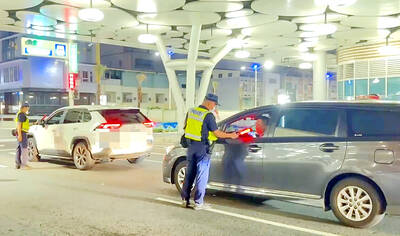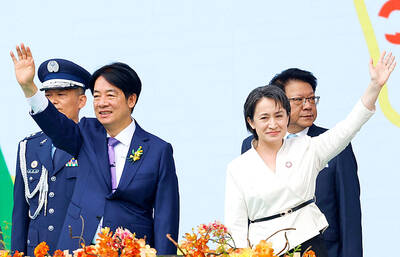The annual ridership of the Taipei Mass Rapid Transit (MRT) system is expected to top 6 billion passengers today, marking a new chapter in MRT services since the system’s inception in 1996, the Taipei Rapid Transit Corp (TRTC) said yesterday.
As of Friday, the Taipei MRT system posted a ridership total of 5.99 billion passengers this year, according to the TRTC, operator of the MRT.
Expanding from one route in March 1996, the Taipei MRT system now encompasses 10 routes connecting many districts in the greater Taipei area.
To mark the new record, the TRTC will hold celebration activities at five major stations — Taipei Main, Zhongxiao Xinsheng, Zhongxiao Fuxing, Minquan W Road and Guting — at 2pm today.
A color-matching lucky draw activity will ask participants to recite the password “Celebrating 6 billion MRT passengers” before taking a colored ball from a box.
Those who guess the right color will receive a limited edition flash drive bracelet. Both the balls and bracelets are in the red, orange, blue, green and brown of the MRT lines.
All participants will receive a commemorative silicone bracelet TRTC public relations division director Leo Ling (凌啟堯) said.
The TRTC will also celebrate the milestone with a concert next week on Saturday afternoon in front of MRT Jiannan Station, with passengers wearing the bracelets enjoying unlimited free rides throughout the day, he said.
The company is seeking to complete the construction of MRT Xinyi Line by the end of this year.
The 6.4km Xinyi Line, the city’s second east-west route after the Bannan Line, is set to include seven stations: Chiang Kai-shek Memorial Hall, Dongmen, Daan Park, Daan, Xinyi Anhe, Taipei 101-World Trade Center and Elephant Mountain.

TRAFFIC SAFETY RULES: A positive result in a drug test would result in a two-year license suspension for the driver and vehicle, and a fine of up to NT$180,000 The Ministry of Transportation and Communications is to authorize police to conduct roadside saliva tests by the end of the year to deter people from driving while under the influence of narcotics, it said yesterday. The ministry last month unveiled a draft of amended regulations governing traffic safety rules and penalties, which included provisions empowering police to conduct mandatory saliva tests on drivers. While currently rules authorize police to use oral fluid testing kits for signs of drug use, they do not establish penalties for noncompliance or operating procedures for officers to follow, the ministry said. The proposed changes to the regulations require

The Executive Yuan yesterday announced that registration for a one-time universal NT$10,000 cash handout to help people in Taiwan survive US tariffs and inflation would start on Nov. 5, with payouts available as early as Nov. 12. Who is eligible for the handout? Registered Taiwanese nationals are eligible, including those born in Taiwan before April 30 next year with a birth certificate. Non-registered nationals with residence permits, foreign permanent residents and foreign spouses of Taiwanese citizens with residence permits also qualify for the handouts. For people who meet the eligibility requirements, but passed away between yesterday and April 30 next year, surviving family members

Taiwanese officials are courting podcasters and influencers aligned with US President Donald Trump as they grow more worried the US leader could undermine Taiwanese interests in talks with China, people familiar with the matter said. Trump has said Taiwan would likely be on the agenda when he is expected to meet Chinese President Xi Jinping (習近平) next week in a bid to resolve persistent trade tensions. China has asked the White House to officially declare it “opposes” Taiwanese independence, Bloomberg reported last month, a concession that would mark a major diplomatic win for Beijing. President William Lai (賴清德) and his top officials

The German city of Hamburg on Oct. 14 named a bridge “Kaohsiung-Brucke” after the Taiwanese city of Kaohsiung. The footbridge, formerly known as F566, is to the east of the Speicherstadt, the world’s largest warehouse district, and connects the Dar-es-Salaam-Platz to the Brooktorpromenade near the Port of Hamburg on the Elbe River. Timo Fischer, a Free Democratic Party member of the Hamburg-Mitte District Assembly, in May last year proposed the name change with support from members of the Social Democratic Party and the Christian Democratic Union. Kaohsiung and Hamburg in 1999 inked a sister city agreement, but despite more than a quarter-century of